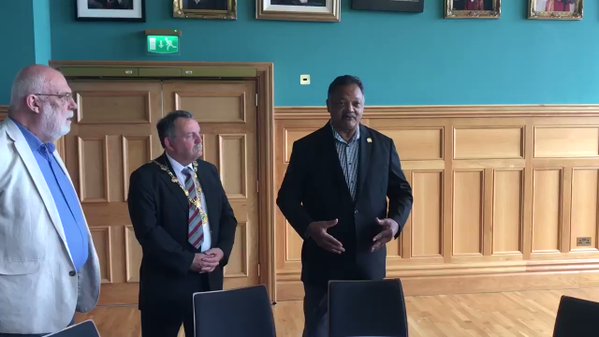 THE US civil rights activist, the Rev Jesse Jackson, is due to open today the new Museum of Free Derry along with Fiachra McGuinness, son of the late Martin McGuinness.
THE US civil rights activist, the Rev Jesse Jackson, is due to open today the new Museum of Free Derry along with Fiachra McGuinness, son of the late Martin McGuinness.
Rev Jackson was welcomed to the city on Wednesday by Major of Derry City and Strabane District Council, Councillor Maoliosa McHugh during a civic reception in the Guildhall.
The official launch will take place on Thursday, seven years to the day since the findings of the report of the Bloody Sunday Inquiry.
The museum opened to the public in February 2017.
Visitors can enjoy a multimedia exhibition and artwork.
A number of exhibitions in the museum tell the people’s story of the civil rights movement, the Battle of the Bogside, internment, Free Derry and Bloody Sunday.
On 30 January 1972, 13 civil rights marchers were shot dead in Derry by the Army in what became known as Bloody Sunday. Another died from his injuries a few months later.
In 2010, the Saville Inquiry found that the 14 demonstrators and bystanders were killed without justification.
The artwork on the front wall of the museum was created by local artist Locky Morris and is entitled We Shall Overcome.
It uses the actual sound waveform of the moment on Bloody Sunday when the crowd sang the civil rights anthem.
Those 21 seconds have been cut into the fabric of the building and are intended to be seen as a “paean to community resistance amidst deadly force”.
Bloody Sunday Trust Chairperson Robin Percival said: “We are all thrilled to officially open the new Museum of Free Derry after a hugely successful first few months in our flagship building.
“While it has been a long and hard road, we are proud to be back in the heart of the Bogside, where so much of our story happened.”
Terence Brannigan, who is the Tourism NI Chairman, said that the museum further strengthens the visitor offering in the North West.
“It is an attraction worthy of domestic, national and international appeal,” he said.
“The ever-increasing visitor numbers are testament to the Museum of Free Derry’s enhanced facilities and focus on the ever popular local heritage special interest groups.”
Tags:




